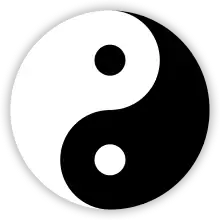Three Sovereigns and Five Emperors
The Three Sovereigns and Five Emperors were two groups of mythological rulers in ancient north China. The Three Sovereigns supposedly lived long before The Five Emperors, who have been assigned dates in a period from 3162 BC to 2070 BC. Today they may be considered culture heroes.[1]
Era of the Three Sovereigns and Five Emperors | |||||||||
|---|---|---|---|---|---|---|---|---|---|
| c. 3162 BC–c. 2070 BC | |||||||||
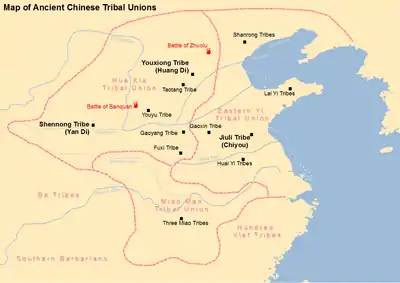 Map of tribes and tribal unions in Ancient China, including the tribes led by Huang Di, Yan Di and Chiyou. | |||||||||
| Status | Legendary kingdom | ||||||||
| Capital | Qufu | ||||||||
| Common languages | Old Chinese, Sinitic languages | ||||||||
| Government | Tribal kingship, Chiefdom | ||||||||
| Di | |||||||||
• 2698–2598 BC | Huangdi | ||||||||
• 2514–2436 BC | Zhuanxu | ||||||||
• 2436–2366 BC | Kù | ||||||||
• 2366–2358 BC | Zhì | ||||||||
• 2356–2255 BC | Yáo | ||||||||
• 2255–2208 BC | Shùn | ||||||||
| History | |||||||||
• Established | c. 3162 BC | ||||||||
• Disestablished | c. 2070 BC | ||||||||
| |||||||||
| Three Sovereigns and Five Emperors | |||||||||||||||
|---|---|---|---|---|---|---|---|---|---|---|---|---|---|---|---|
| Chinese | 三皇五帝 | ||||||||||||||
| Literal meaning | three huang ("magnificent ones"), five di ("lords of heaven") | ||||||||||||||
| |||||||||||||||
 | |||
|---|---|---|---|
ANCIENT | |||
IMPERIAL | |||
MODERN | |||
Related articles
| |||
The dates of these mythological figures may be fictitious, but according to some accounts and reconstructions, they supposedly preceded the Xia Dynasty.[2]
Description
The Three Sovereigns, sometimes known as the Three August Ones, were said to be god-kings or demigods[3] who used their divine abilities to improve the lives of the Chinese peoples and gift them essential skills and valuable knowledge. The Five Emperors are portrayed as exemplary ancestral sages who possessed a great moral character and lived to an extremely old age and ruled over a period of great chinese peace. The Three Sovereigns on the other hand are ascribed various identities in different Chinese historical texts.
These high kings are said to have helped introduce the first use of fire, taught people how to build good houses and farm. Leizu, wife of Huangdi, is credited with the invention of silk culture. The discovery of medicine, the invention of the calendar and Chinese script are also credited to the 5 Emperors. After their era, Yu the Great founded the Xia Dynasty.[2]
According to a modern theory with roots in the late 19th century, the Yellow Emperor is supposedly the ancestor of the Huaxia people.[4] The Mausoleum of the Yellow Emperor was established in Shaanxi Province to commemorate the ancestry legend.[4]
The Chinese word for emperor, huángdì (皇帝), derives from this, as the first user of this title Qin Shi Huang considered his reunion of all of the lands of the former Kingdom of Zhou to be greater than even the Three Sovereigns and Five Emperors.
Clan
A related concept appears in the legend of the Four shi (四氏) who took part in creating the world. The four members are Youchao-shi (有巢氏), Suiren-shi (燧人氏), Fuxi-shi (伏羲氏), and Shennong-shi (神農氏). The list sometimes extends to one more member being Nüwa-shi (女媧氏), making Five shi (五氏).[5] Four of these five names appear in different lists of the Three Sovereigns. Shi (氏) means clan or family, so none of them are a single person in prehistoric times.
There is a saying that the Three Sovereigns are Suiren-shi (燧人氏), Youchao-shi (有巢氏), Shennong-shi (神農氏). The Suiren taught people to drill wood for fire so people could easily migrate. The Youchao taught people to build houses out of wood, so that people could leave caves to expand into the plains. After the number of people grew, Shennong tried a variety of grasses to find suitable herbs to solve people's food problems. The tribes also used the sovereigns' respective contributions as the name of the tribes.
Variations
Depending on the source, there are many variations of who classifies as the Three Sovereigns or the Five Emperors. There are at least six to seven known variations.[6] Many of the sources listed below were written in much later periods, centuries and even millennia after the supposed existence of these figures, and instead of historical fact, they may reflect a desire in later time periods to create a fictitious ancestry traceable to ancient culture heroes. The Emperors were asserted as ancestors of the Xia, Shang, and Zhou dynasties.[7] The following appear in different groupings of the Three Sovereigns: Fuxi (伏羲), Nüwa (女媧), Shennong (神農), Suiren (燧人), Zhurong (祝融), Gong Gong (共工), Heavenly Sovereign (天皇), Earthly Sovereign (地皇), Tai Sovereign (泰皇), Human Sovereign (人皇), and even the Yellow Emperor (黃帝).
The following appear in different groupings of the Five Emperors: Fuxi (Taihao/ 太昊), Yan Emperor (炎帝), Yellow Emperor (黃帝), Shaohao (少昊), Zhuanxu (顓頊), Emperor Ku (嚳), Emperor Yao (堯), Emperor Shun (舜).
| Source | Date of source | Three Sovereigns | Five Emperors |
|---|---|---|---|
| Records of the Grand Historian (《史記》) edition by Sima Qian[note 1] |
94 BC |
|
|
| Sovereign series (帝王世系)(book written by Huangfu Mi)[6] |
|
| |
| Shiben[6] | 475–221 BC (the Warring States period) according to the Book of Han (AD 111) |
|
|
| Baihu Tongyi (白虎通義)[6] |
|
||
| Fengsu TongYi (風俗通義)[6] | AD 195 |
|
|
| Yiwen Leiju (藝文類聚)[6] | AD 624 |
|
|
| Tongjian Waiji (通鑑外紀) |
|
||
|
|
||
| Shangshu dazhuan (尚書大傳) |
|
||
| Diwang shiji(book written by Huangfu Mi) (帝王世紀) |
|
||
| I Ching (易經)[6] | 800s BC |
| |
| Comments of a Recluse, Qianfulun (潛夫論)[8] |
| ||
| Zizhi tongjian waiji, (資治通鑒外紀)[8] |
| ||
Lineage of the Five Emperors
| Family tree of ancient Five Emperors | |||||||||||||||||||||||||||||||||||||||||||||||||||||||||||||||||||||||||||||||||||||||||||||||||||||||||||||||||||||||||||||||||||||||||||||||||||||||||||||||||||||||||||||||||||||||||||||||||||||||||||||||||||||||||||||||||||||||||||||||||||||||||||||||||||||||||||||||||||||||||||||||||||||||||||||||||||||||||||||||||||||||||||||||||||||||||||||||||||||||||||||||||||||||||||||||||||||||||||||||||||||||||||||||||||||||||||||||||||||||||||||||||||||||||||||||||||||||||||||||||||||||||||||||||||||||||||||||||||||||||||||||||||||||||||||||||||||||||||||||||||||||||||||||||||||||||||||||||||||||||||||||||||||||||||||||||||||||||||||||||||||||||||||||||||||||||||||||||||||||||||||||||||||||||||||||||||||||||||||||||||||||||||||||||||||||||||||||||||||||||||||||||||||||||||||||||||||||||||||||||||||||||||||||||||||||||||||||||||||||||||||||||||||||||||||||||||||||||||||||||||||||||||||||||||||||||||||||||||||||||||||||||||||||||||||||||||||||||||||||||||||||||||||||||||||||||||||||||||||||
|---|---|---|---|---|---|---|---|---|---|---|---|---|---|---|---|---|---|---|---|---|---|---|---|---|---|---|---|---|---|---|---|---|---|---|---|---|---|---|---|---|---|---|---|---|---|---|---|---|---|---|---|---|---|---|---|---|---|---|---|---|---|---|---|---|---|---|---|---|---|---|---|---|---|---|---|---|---|---|---|---|---|---|---|---|---|---|---|---|---|---|---|---|---|---|---|---|---|---|---|---|---|---|---|---|---|---|---|---|---|---|---|---|---|---|---|---|---|---|---|---|---|---|---|---|---|---|---|---|---|---|---|---|---|---|---|---|---|---|---|---|---|---|---|---|---|---|---|---|---|---|---|---|---|---|---|---|---|---|---|---|---|---|---|---|---|---|---|---|---|---|---|---|---|---|---|---|---|---|---|---|---|---|---|---|---|---|---|---|---|---|---|---|---|---|---|---|---|---|---|---|---|---|---|---|---|---|---|---|---|---|---|---|---|---|---|---|---|---|---|---|---|---|---|---|---|---|---|---|---|---|---|---|---|---|---|---|---|---|---|---|---|---|---|---|---|---|---|---|---|---|---|---|---|---|---|---|---|---|---|---|---|---|---|---|---|---|---|---|---|---|---|---|---|---|---|---|---|---|---|---|---|---|---|---|---|---|---|---|---|---|---|---|---|---|---|---|---|---|---|---|---|---|---|---|---|---|---|---|---|---|---|---|---|---|---|---|---|---|---|---|---|---|---|---|---|---|---|---|---|---|---|---|---|---|---|---|---|---|---|---|---|---|---|---|---|---|---|---|---|---|---|---|---|---|---|---|---|---|---|---|---|---|---|---|---|---|---|---|---|---|---|---|---|---|---|---|---|---|---|---|---|---|---|---|---|---|---|---|---|---|---|---|---|---|---|---|---|---|---|---|---|---|---|---|---|---|---|---|---|---|---|---|---|---|---|---|---|---|---|---|---|---|---|---|---|---|---|---|---|---|---|---|---|---|---|---|---|---|---|---|---|---|---|---|---|---|---|---|---|---|---|---|---|---|---|---|---|---|---|---|---|---|---|---|---|---|---|---|---|---|---|---|---|---|---|---|---|---|---|---|---|---|---|---|---|---|---|---|---|---|---|---|---|---|---|---|---|---|---|---|---|---|---|---|---|---|---|---|---|---|---|---|---|---|---|---|---|---|---|---|---|---|---|---|---|---|---|---|---|---|---|---|---|---|---|---|---|---|---|---|---|---|---|---|---|---|---|---|---|---|---|---|---|---|---|---|---|---|---|---|---|---|---|---|---|---|---|---|---|---|---|---|---|---|---|---|---|---|---|---|---|---|---|---|---|---|---|---|---|---|---|---|---|---|---|---|---|---|---|---|---|---|---|---|---|---|---|---|---|---|---|---|---|---|---|---|---|---|---|---|---|---|---|---|---|---|---|---|---|---|---|---|---|---|---|---|---|---|---|---|---|---|---|---|---|---|---|---|---|---|---|---|---|---|---|---|---|---|---|---|---|---|---|---|---|---|---|---|---|---|---|---|---|---|---|---|---|---|---|---|---|---|---|---|---|---|---|---|---|---|---|---|---|---|---|---|---|---|---|---|---|---|---|---|---|---|---|---|---|---|---|---|---|---|---|---|---|---|---|---|---|---|---|---|---|---|---|---|---|---|---|---|---|---|---|---|---|---|---|---|---|---|---|---|---|---|---|---|---|---|---|---|---|---|---|---|---|---|---|---|---|---|---|---|---|---|---|---|---|---|---|---|---|---|---|---|---|---|---|---|---|---|---|---|---|---|---|---|---|---|---|---|---|---|---|---|---|---|---|---|---|---|---|---|---|---|---|---|---|---|---|---|---|---|---|---|---|---|---|---|---|---|---|---|---|---|---|---|---|---|---|---|---|---|---|---|---|---|---|---|---|---|---|---|---|---|---|---|---|---|---|---|---|---|---|---|---|---|---|---|---|---|---|---|---|---|---|---|---|---|---|---|---|---|---|---|---|---|---|---|---|---|---|---|---|---|---|---|---|---|---|---|---|---|---|---|---|---|---|---|---|---|---|---|---|---|---|---|---|---|---|---|---|---|---|---|---|---|---|---|---|---|---|---|---|---|---|---|---|---|---|---|---|---|---|---|---|---|---|---|---|---|---|---|---|---|---|---|---|---|---|---|---|---|---|---|---|---|---|---|---|---|---|---|---|---|---|---|---|---|---|---|---|---|---|---|---|---|---|---|---|---|---|---|---|---|---|---|---|---|---|---|---|---|---|---|---|---|---|
Numbers in parenthesis mark a possible enthronement order of the emperors that are considered by one or more authorities to be among the "Five Emperors". | |||||||||||||||||||||||||||||||||||||||||||||||||||||||||||||||||||||||||||||||||||||||||||||||||||||||||||||||||||||||||||||||||||||||||||||||||||||||||||||||||||||||||||||||||||||||||||||||||||||||||||||||||||||||||||||||||||||||||||||||||||||||||||||||||||||||||||||||||||||||||||||||||||||||||||||||||||||||||||||||||||||||||||||||||||||||||||||||||||||||||||||||||||||||||||||||||||||||||||||||||||||||||||||||||||||||||||||||||||||||||||||||||||||||||||||||||||||||||||||||||||||||||||||||||||||||||||||||||||||||||||||||||||||||||||||||||||||||||||||||||||||||||||||||||||||||||||||||||||||||||||||||||||||||||||||||||||||||||||||||||||||||||||||||||||||||||||||||||||||||||||||||||||||||||||||||||||||||||||||||||||||||||||||||||||||||||||||||||||||||||||||||||||||||||||||||||||||||||||||||||||||||||||||||||||||||||||||||||||||||||||||||||||||||||||||||||||||||||||||||||||||||||||||||||||||||||||||||||||||||||||||||||||||||||||||||||||||||||||||||||||||||||||||||||||||||||||||||||||||||
Gallery
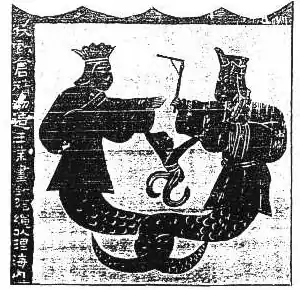 Fuxi and Nüwa
Fuxi and Nüwa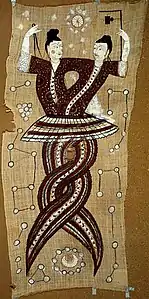 Another depiction of Fuxi and Nüwa
Another depiction of Fuxi and Nüwa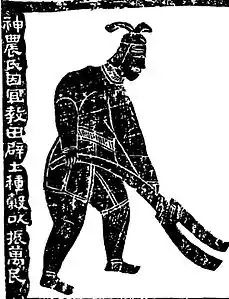

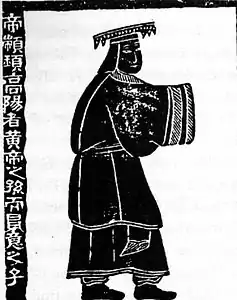 Zhuanxu
Zhuanxu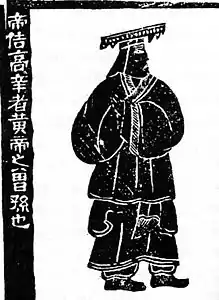 Emperor Ku
Emperor Ku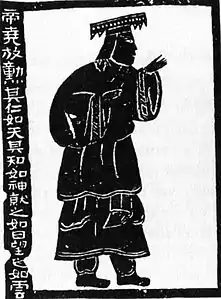 Emperor Yao
Emperor Yao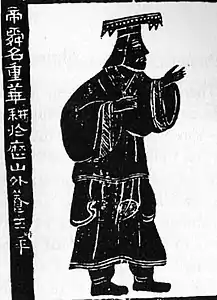 Emperor Shun
Emperor Shun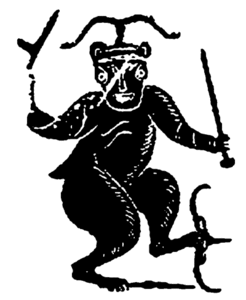 Chi You
Chi You
See also
- Wufang Shangdi, the Five Emperors
- List of Neolithic cultures of China
- Dawenkou culture
- Liangzhu culture
- Majiayao culture
- Qujialing culture
- Longshan culture
- Baodun culture
- Shijiahe culture
- Emperor of China
Notes
- Sima Qian only lists the names of the Three Sovereigns fleetingly in the "Basic Annals of Qin Shihuang" (《秦始皇本紀》): "古有天皇,有地皇,有泰皇". Details were supplied by the "Basic Annals of the Three Sovereigns" (《三皇本紀》), written centuries later by Sima Zhen as a supplement to the Records (《補史記》). The 《三皇本紀》 has sometimes been conflated with the Records proper (e.g., by the Gujin Tushu Jicheng), but the original Records begins with the Basic Annals of the Five Emperors (《五帝本紀》), without mentioning the Three Sovereigns.
References
- Hucker, Charles (1995). China's Imperial Past: An Introduction to Chinese History and Culture. Stanford University Press. p. 22. ISBN 9780804723534.
- Morton, W. Scott; Lewis, Charlton M. (2005). China: its history and culture. McGraw-Hill. p. 14. ISBN 978-0-07-141279-7.
- Eliade, Mircea; Adams, Charles J., eds. (1987). The Encyclopedia of religion. Vol. 9, Liu–Mith. Macmillan. p. 133.
- 王恆偉 (2005). Zhongguo li shi jiang tang #1 Yuan gu zhi Chun Qiu 中國歷史講堂 #1 遠古至春秋 [Chinese History Lectures #1: Ancient times to Spring and Autumn period]. 中華書局. p. 13. ISBN 962-8885-24-3.
- 王恆偉 (2005). Zhongguo li shi jiang tang #1 Yuan gu zhi Chun Qiu 中國歷史講堂 #1 遠古至春秋 [Chinese History Lectures #1: Ancient times to Spring and Autumn period]. 中華書局. pp. 4–7. ISBN 962-8885-24-3.
- 劉煒 (2002). 原始社会 中华文明传真 [Chinese civilization in a new light]. Commercial press publishing. p. 142. ISBN 962-07-5314-3.
- Soothill, William Edward; Hosie, Dorothea Lady; Hudson, G. F. (2002). The Hall of Light: A Study of Early Chinese Kingship. James Clarke & Co. pp. 146–. ISBN 978-0-227-17123-3.
- Ulrich Theobald. "Sanhuang wudi 三皇五帝, the Three Augusts and Five Emperors". ChinaKnowledge.de.
- Bamboo Annals
- I Ching
- Book of Rites
- Sima Qian, Records of the Grand Historian
- Zhang, Qizhi (2015-04-15). An Introduction to Chinese History and Culture. Springer. p. 3. ISBN 978-3-662-46482-3.
- Sima Qian, Records of the Grand Historian
- Sima Qian, Records of the Grand Historian
- I Ching
- Classic of Mountains and Seas
Further reading
- . Translated by Allen, Herbert J. "Ssŭma Ch'ien's Historical Records, Introductory Chapter". Journal of the Royal Asiatic Society. 26 (2): 269–295. 1894. doi:10.1017/S0035869X00143916. S2CID 161670530.
- "The Annals of the Bamboo Books: The reigns of Huang-te, Che, Chuen-heuh and Hëen-Yuen; The reigns of Yaou and Shun". The Chinese Classics, volume 3, part 1. Translated by Legge, James. 1865. pp. 108–116.
